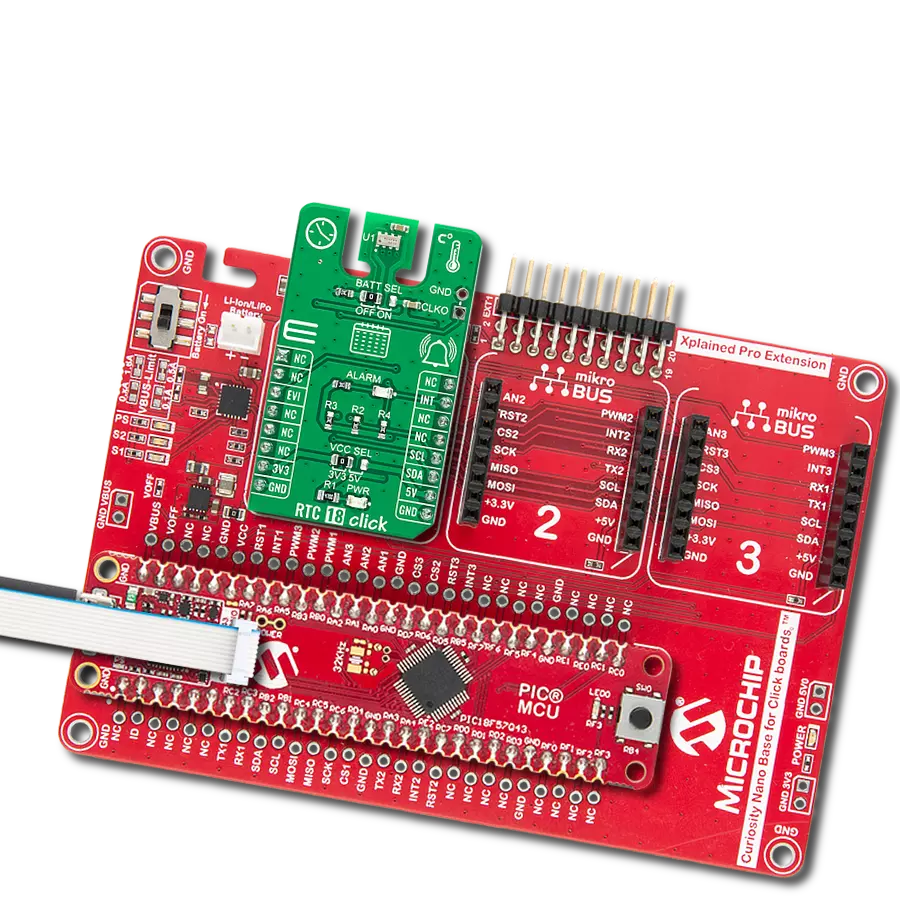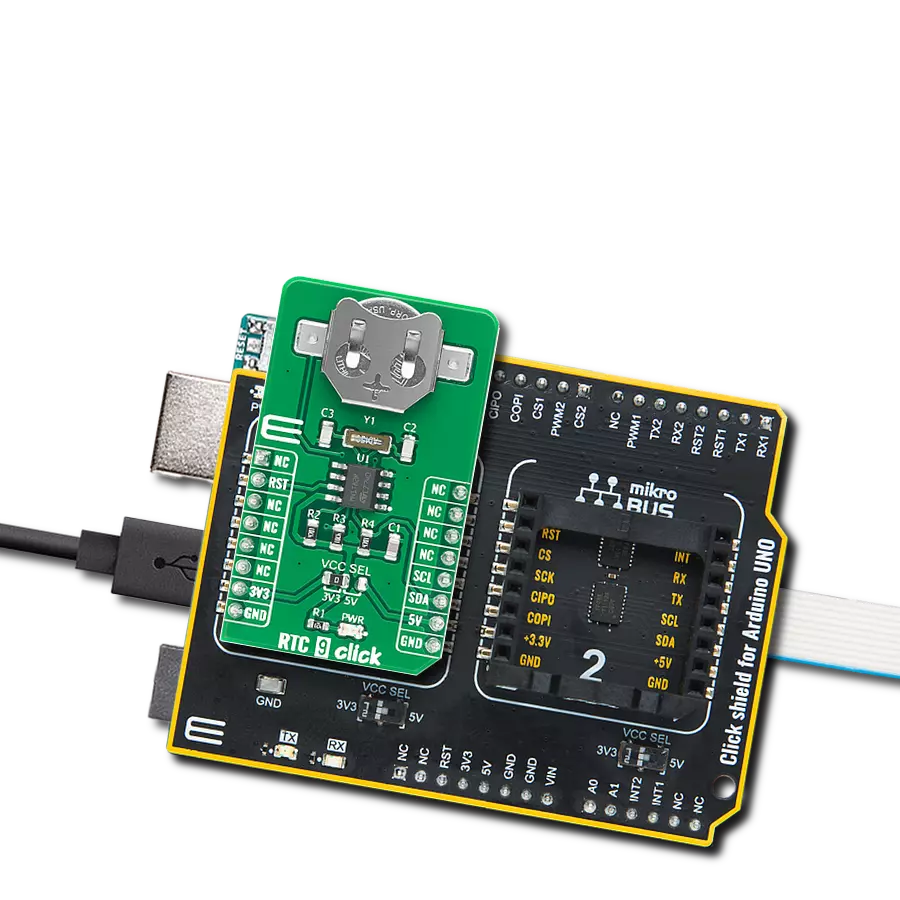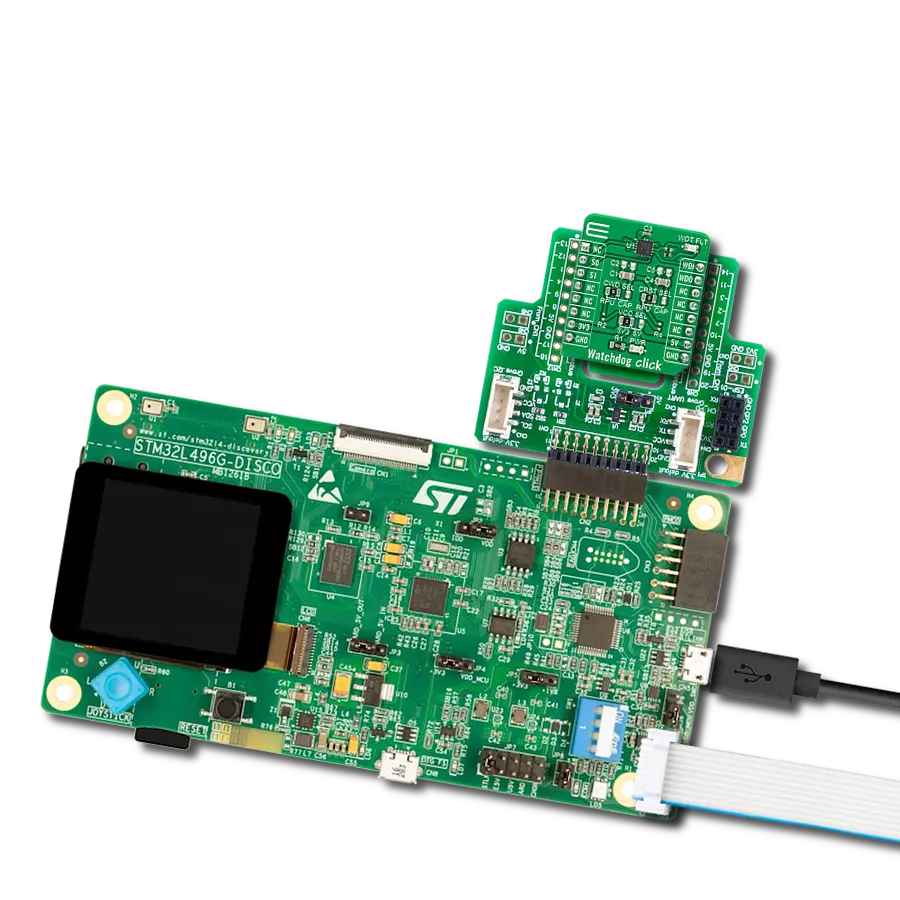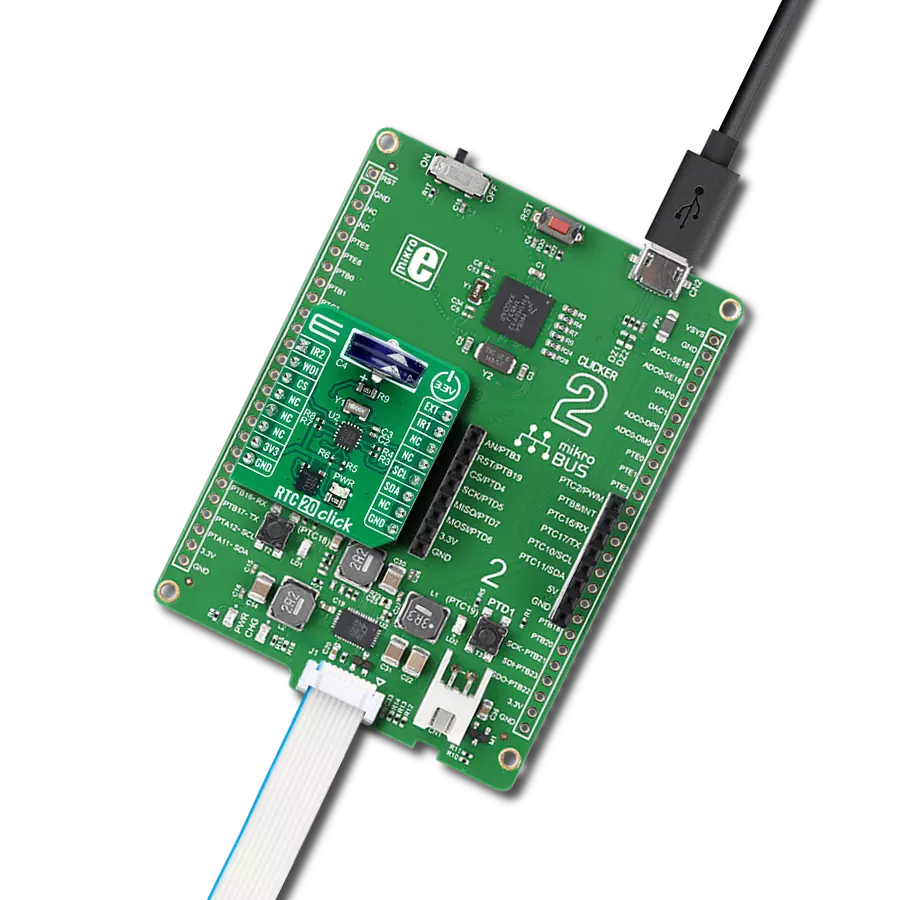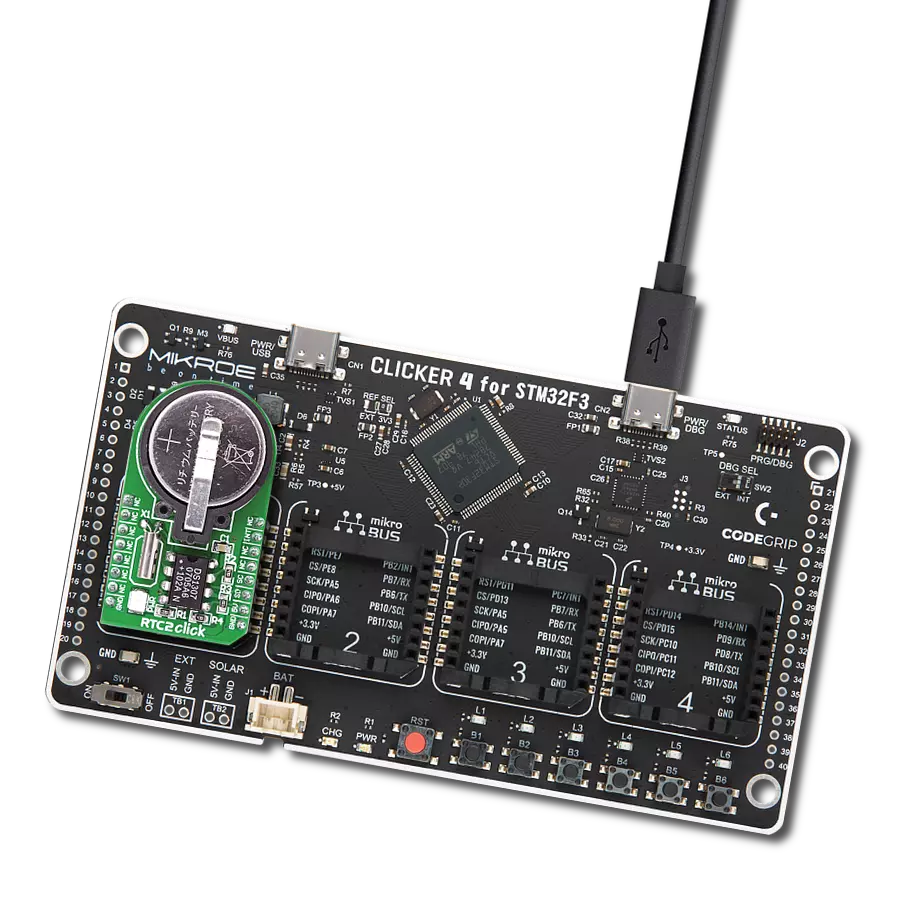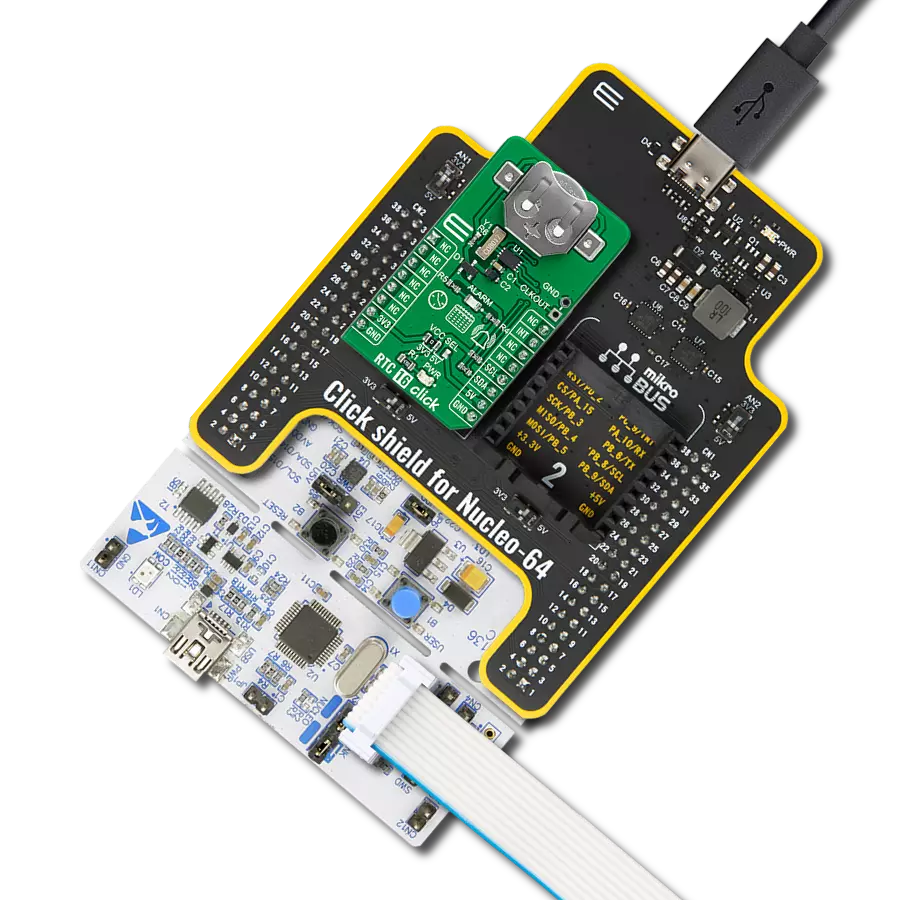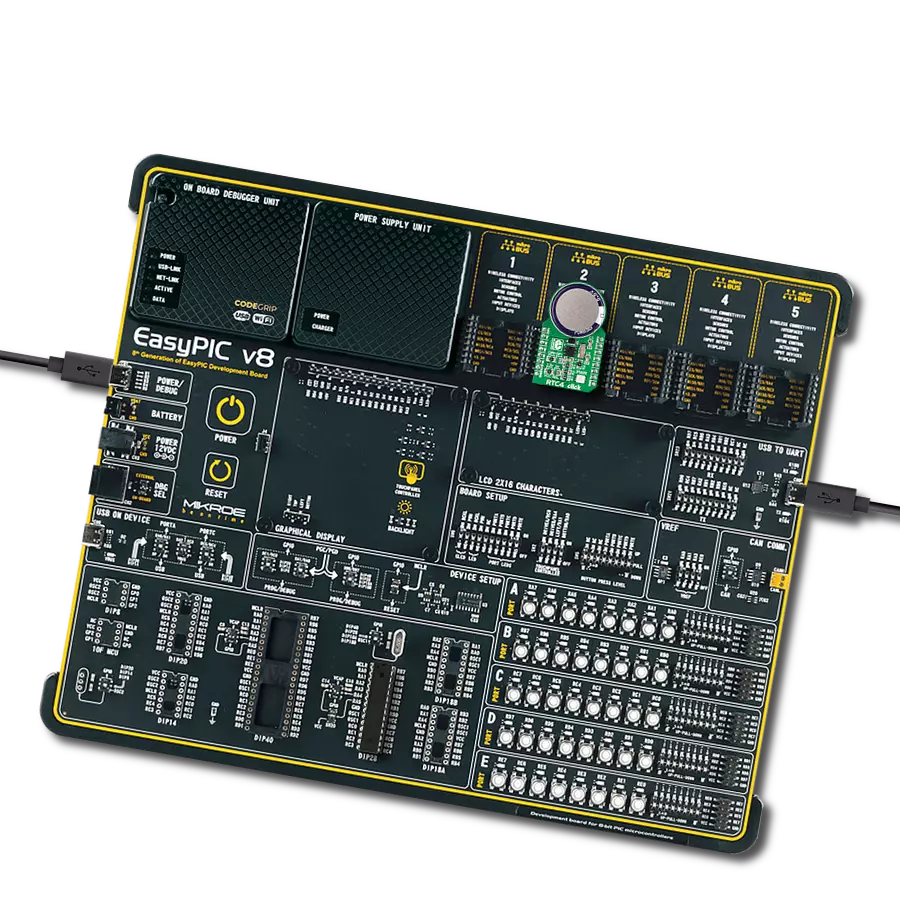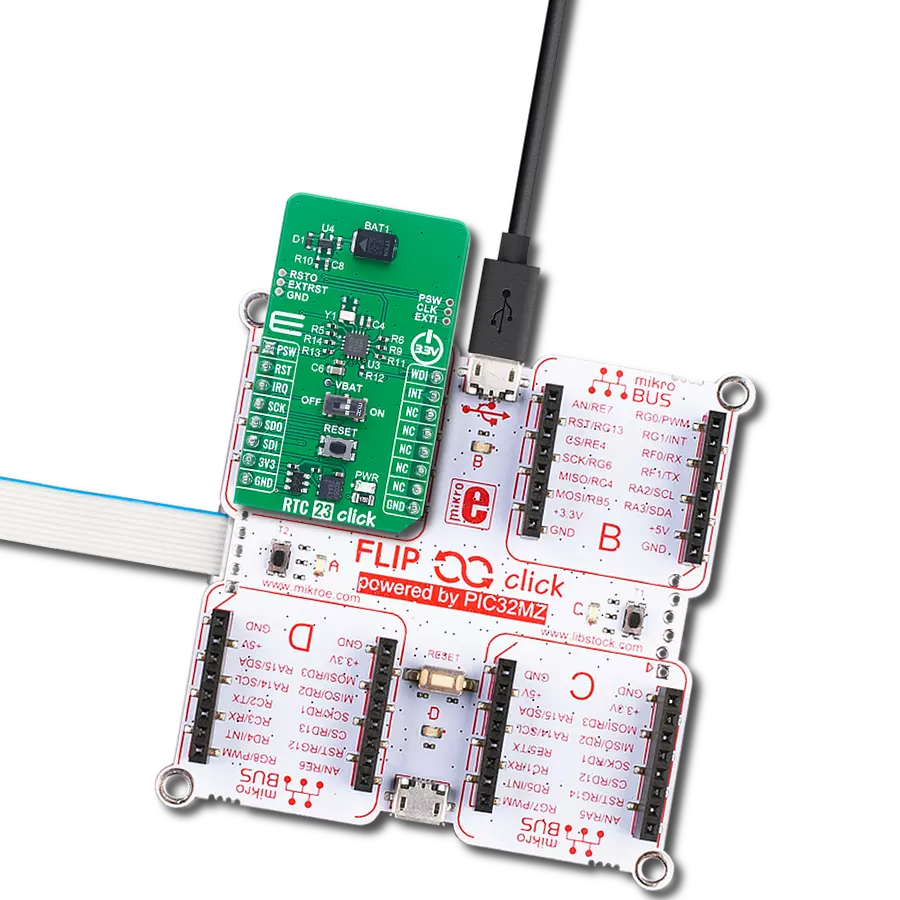Experience the power of precise timekeeping in your engineering projects by integrating state-of-the-art real-time clock solution
A
A
Hardware Overview
How does it work?
RTC 7 Click is based on the MAX31341B, a low-current Real-Time Clock with I2C interface and power management from Analog Devices. Thanks to its high integration level, this module provides high time accuracy, with a very low count of external components required. It has a full RTC function, offering programmable counters, alarms, and an interrupt engine with selectable event reporting sources. The small dimension of the MAX31341B module itself, allow it to be used in very space-constrained applications, including wearables, medical equipment, and similar. In addition to the MAX31341B, RTC 7 click is equipped with the 220mF super capacitor. By utilizing an automatic backup switch, the IC is able to use an external battery power source when there is no power supply on its main power terminals, thus allowing for uninterrupted operation. Draining as low as 180nA of current, it can be operated with the mentioned supercapacitor almost indefinitely.
In addition, a trickle charge system will replenish the super capacitor while the MAX31341B is powered over the main power terminals (VDD, VSS). The voltage of the main power supply can range between 1.6V up to 3.6V. The MAX31341B uses the I2C communication protocol for the communication with the host MCU. Besides the I2C bus lines, two additional pins are also available on the MAX31341B, INTA and INTB, allowing an interrupt to be reported to the host MCU, but also to capture an external event and marking it with an automatic timestamp. The two mentioned interrupt pins are routed to INT and AN pins of the mikroBUS™ socket, respectively. The user is able to set up standard clock and calendar functions (including seconds, minutes, hours, weekdays, date, months, years with leap year correction), as well as the interrupt functions for the periodic countdown timer, periodic time update, alarm, external event, automatic backup switchover and
power on reset (POR) events. All these features are available when the module is operated over the backup power supply (battery). Besides other functions, RTC 7 click have one analog and one digitital external input, labeled AIN and DIN. These universal inputs can be wired to any kind of external trigger, which needs to trigger one of the interrupts. The digital input can be configured to detect rising or falling edge, while the analog input, besides the edge detection, supports the programmable threshold too. For detailed information on interrupts and external triggers, refer to the MAX31341B datasheet. This Click board™ can be operated only with a 3.3V logic voltage level. The board must perform appropriate logic voltage level conversion before using MCUs with different logic levels. Also, it comes equipped with a library containing functions and an example code that can be used as a reference for further development.
Features overview
Development board
Curiosity PIC32 MZ EF development board is a fully integrated 32-bit development platform featuring the high-performance PIC32MZ EF Series (PIC32MZ2048EFM) that has a 2MB Flash, 512KB RAM, integrated FPU, Crypto accelerator, and excellent connectivity options. It includes an integrated programmer and debugger, requiring no additional hardware. Users can expand
functionality through MIKROE mikroBUS™ Click™ adapter boards, add Ethernet connectivity with the Microchip PHY daughter board, add WiFi connectivity capability using the Microchip expansions boards, and add audio input and output capability with Microchip audio daughter boards. These boards are fully integrated into PIC32’s powerful software framework, MPLAB Harmony,
which provides a flexible and modular interface to application development a rich set of inter-operable software stacks (TCP-IP, USB), and easy-to-use features. The Curiosity PIC32 MZ EF development board offers expansion capabilities making it an excellent choice for a rapid prototyping board in Connectivity, IOT, and general-purpose applications.
Microcontroller Overview
MCU Card / MCU

Architecture
PIC32
MCU Memory (KB)
2048
Silicon Vendor
Microchip
Pin count
100
RAM (Bytes)
524288
Used MCU Pins
mikroBUS™ mapper
Take a closer look
Click board™ Schematic

Step by step
Project assembly
Software Support
Library Description
This library contains API for RTC 7 Click driver.
Key functions:
rtc7_check_interrupt- This function returns the interrupt state, state of INTA pinrtc7_read_reg- This function writes one byte data to the registerrtc7_get_local_time- This function gets the local time data including the determined time zone in calculations
Open Source
Code example
The complete application code and a ready-to-use project are available through the NECTO Studio Package Manager for direct installation in the NECTO Studio. The application code can also be found on the MIKROE GitHub account.
/*!
* \file
* \brief RTC7 Click example
*
* # Description
* This app is used to accurately measure time with low power consumption.
*
* The demo application is composed of two sections :
*
* ## Application Init
* Initializes device.
*
* ## Application Task
* Waits for a second count-up interrupt and then reads and logs the current
* time and date on the USB UART.
*
* \author MikroE Team
*
*/
// ------------------------------------------------------------------- INCLUDES
#include "board.h"
#include "log.h"
#include "rtc7.h"
// ------------------------------------------------------------------ VARIABLES
static rtc7_t rtc7;
static log_t logger;
rtc7_time_t time_set;
rtc7_time_t time_date;
// ------------------------------------------------------- ADDITIONAL FUNCTIONS
void rtc7_display_results ( rtc7_t *ctx )
{
log_printf( &logger, " %.2u:%.2u:%.2u\r\n",
( uint16_t ) time_date.hours, ( uint16_t ) time_date.minutes, ( uint16_t ) time_date.seconds );
log_printf( &logger, " %.2u/%.2u/%.2u ",
( uint16_t ) time_date.monthday, ( uint16_t ) time_date.month, ( uint16_t ) time_date.year );
switch ( time_date.weekdays )
{
case 1:
{
log_printf( &logger, "MONDAY" );
break;
}
case 2:
{
log_printf( &logger, "TUESDAY" );
break;
}
case 3:
{
log_printf( &logger, "WEDNESDAY" );
break;
}
case 4:
{
log_printf( &logger, "THURSDAY" );
break;
}
case 5:
{
log_printf( &logger, "FRIDAY" );
break;
}
case 6:
{
log_printf( &logger, "SATURDAY" );
break;
}
case 7:
{
log_printf( &logger, "SUNDAY" );
break;
}
default:
{
break;
}
}
log_printf( &logger, "\r\n-------------------\r\n" );
}
// ------------------------------------------------------ APPLICATION FUNCTIONS
void application_init ( void )
{
log_cfg_t log_cfg;
rtc7_cfg_t cfg;
/**
* Logger initialization.
* Default baud rate: 115200
* Default log level: LOG_LEVEL_DEBUG
* @note If USB_UART_RX and USB_UART_TX
* are defined as HAL_PIN_NC, you will
* need to define them manually for log to work.
* See @b LOG_MAP_USB_UART macro definition for detailed explanation.
*/
LOG_MAP_USB_UART( log_cfg );
log_init( &logger, &log_cfg );
log_info( &logger, " Application Init " );
// Click initialization.
rtc7_cfg_setup( &cfg );
RTC7_MAP_MIKROBUS( cfg, MIKROBUS_1 );
rtc7_init( &rtc7, &cfg );
Delay_ms ( 300 );
time_set.seconds = 40;
time_set.minutes = 59;
time_set.hours = 23;
time_set.weekdays = 1;
time_set.monthday = 31;
time_set.month = 12;
time_set.year = 22;
err_t error_flag = rtc7_reset( &rtc7 );
error_flag |= rtc7_init_time ( &rtc7, 0 );
error_flag |= rtc7_set_gmt_time( &rtc7, &time_set );
error_flag |= rtc7_set_osc( &rtc7, RTC7_ENABLE_OSC, RTC7_INPUT_FREQ_32768HZ, RTC7_OUTPUT_FREQ_32768HZ );
error_flag |= rtc7_write_reg( &rtc7, RTC7_TIMER_INIT_REG, 15 );
error_flag |= rtc7_set_timer( &rtc7, RTC7_TIMER_EN, RTC7_TIMER_FREQ_16HZ );
Delay_ms ( 100 );
if ( RTC7_ERROR == error_flag )
{
log_error( &logger, " Default configuration." );
for ( ; ; );
}
log_info( &logger, " Application Task " );
}
void application_task ( void )
{
// Wait for timer count-down interrupt which is set to 1Hz
while ( rtc7_check_interrupt ( &rtc7 ) );
// Clear interrupt status
uint8_t int_status = 0;
rtc7_read_reg( &rtc7, RTC7_INT_STATUS_REG, &int_status, 1 );
// Read time
if ( RTC7_OK == rtc7_get_local_time( &rtc7, &time_date ) )
{
// Display time
rtc7_display_results( &rtc7 );
}
}
int main ( void )
{
/* Do not remove this line or clock might not be set correctly. */
#ifdef PREINIT_SUPPORTED
preinit();
#endif
application_init( );
for ( ; ; )
{
application_task( );
}
return 0;
}
// ------------------------------------------------------------------------ END
Additional Support
Resources
Category:RTC























